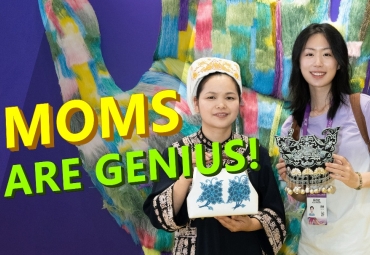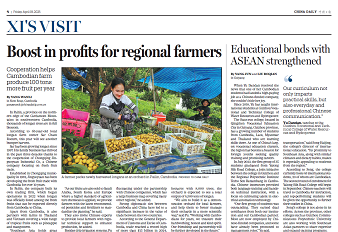Traditional craft creates employment in Guizhou

Peng Yi shows a tiger-shaped cushion she designed and made. CHINA DAILY
Miao embroidery, a national intangible cultural heritage, is helping people in Guizhou province improve their lives through increased incomes and cultural confidence.
Peng Yi, the owner of a Miao embroidery company in Bijie, Guizhou, has devoted herself to inheriting the traditional skill of the Miao people and providing more job opportunities to residents.
Born in Huawu village in Bijie's Qianxi county, Peng grew up watching villagers make traditional Miao clothing and accessories and developed an interest in Miao batik and embroidery.
While in primary school, she attended a class taught by Yang Qiong, an inheritor of Miao embroidery. Peng was impressed by the knowledge and skill behind the ancient craft and made up her mind to become an inheritor herself.
In 2008, Peng became Yang's sole student, but the learning process was not always smooth.
Recalling the tough moments, Peng said the horsetail stitches and paper-cut stitches were the most difficult to master.
When doing horsetail stitches, or maweixiu, the embroiderer stitches hair from a horse's tail at the tip of the pattern on the cloth.
Paper-cut stitches, or jianzhixiu, require the embroiderer to cut the cotton cloth into the desired shapes, sticking up to 10 layers of patterns together, and then stitch the cloth to make it colorful and complete.
To gain more knowledge and master higher-level skills, Peng enrolled at Guizhou Minzu University and earned a master's degree in folk art.
Miao embroidery is more eye-catching and brighter than the four other traditional Chinese embroidery forms, which are found in the provinces of Jiangsu, Sichuan, Hunan and Guangdong. And while their patterns have broader market appeal, Miao embroidery prefers themes of Miao history, water and mountain scenes, and local customs.
Peng's efforts to inherit and spread the ancient skill have been backed by the local government.
Guizhou's provincial government is launching a special plan to assist the development of the Miao embroidery industry by providing free lessons and venues for embroiderers to start their own workshops and brands.
Xiang Songxian began working at Peng's company in 2018. Before that, she worked in Zhejiang province in East China for nearly a decade.
"My mother got sick years ago, so I decided to come back to my hometown to look after her," the 29-year-old said. "There are many advantages to working here. The money I make here is enough to improve my quality of life. I can spend more time with my mother and also master more Miao embroidery skills."
Peng has many ideas about how to develop Miao embroidery, including creating more diversified products, recording the skills and knowledge required so that future generations can master and learn them, and expanding cooperation with other disciplines such as pottery and wooden products to advance the industrialization and marketing potential of the craft.
"What's traditional is also fashionable," President Xi Jinping said during a visit to a workshop in Huawu in February last year, urging the promotion of Miao embroidery to aid rural vitalization.
To celebrate the Lunar New Year, Peng and her colleagues have also designed new products with tiger elements, including a tiger-shaped pillow.
"The pillow we designed uses spiral, sun and floral patterns, indicating expectations of a better life in Miao culture," Peng said.
Zhang Chi contributed to this story.
All rights Reserved. 京ICP备13028878号-8







 Overview
Overview Guiyang
Guiyang Guian New Area
Guian New Area Liupanshui
Liupanshui Anshun
Anshun Qianxinan
Qianxinan Qiandongnan
Qiandongnan Qiannan
Qiannan Zunyi
Zunyi Tongren
Tongren Bijie
Bijie Guizhou commits to culture preservation and rural vitalization
Guizhou commits to culture preservation and rural vitalization Guizhou voice at 2025 national two sessions
Guizhou voice at 2025 national two sessions Meet the 'genius moms' at Shenzhen cultural fair
Meet the 'genius moms' at Shenzhen cultural fair 

